Prince Philip, Duke Of Edinburgh
 From Nwe
From Nwe
-
"Prince Philip" redirects here.
| Prince Philip | ||
|---|---|---|
| Duke of Edinburgh | ||
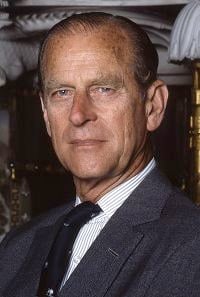 |
||
| Portrait of Prince Philip, Duke of Edinburgh by Allan Warren, 1992 | ||
| Reign | February 6, 1952 – April 9, 2021 | |
| Born | June 10 1921[1] | |
| Mon Repos, Corfu, Kingdom of Greece | ||
| Died | April 9 2021 (aged 99) | |
| Windsor Castle, Windsor, United Kingdom | ||
| Buried | Royal Vault, St George's Chapel, Windsor Castle | |
| Consort | yes | |
| Consort to | Elizabeth II (m. 1947) | |
| Issue |
|
|
| Royal House |
|
|
| Father | Prince Andrew of Greece and Denmark | |
| Mother | Princess Alice of Battenberg | |
Prince Philip, Duke of Edinburgh (born Prince Philip of Greece and Denmark June 10, 1921[1] – April 9, 2021) was a member of the British royal family as the husband of Elizabeth II.
Philip was born into the Greek and Danish royal families. He was born in Greece, but his family was exiled from the country when he was eighteen months old. After being educated in France, Germany, and Great Britain, he joined the Royal Navy in 1939, aged 18. From July 1939, he began corresponding with the thirteen-year-old Princess Elizabeth, whom he had first met in 1934. During the Second World War he served with distinction in the British Mediterranean and Pacific fleets.
After the war, Philip was granted permission by George VI to marry Elizabeth. Before the official announcement of their engagement in July 1947, he abandoned his Greek and Danish titles and styles, became a naturalized British subject, and adopted his maternal grandparents' surname Mountbatten. He married Elizabeth on November 20, 1947. Just before the wedding, he was granted the style His Royal Highness and created Duke of Edinburgh, Earl of Merioneth, and Baron Greenwich by the King. Philip left active military service when Elizabeth became queen in 1952, having reached the rank of commander, and was made a British prince in 1957. Philip had four children with Elizabeth: Charles, Prince of Wales; Anne, Princess Royal; Prince Andrew, Duke of York; and Prince Edward, Earl of Wessex. Through a British Order in Council issued in 1960, descendants of the couple not bearing royal styles and titles can use the surname Mountbatten-Windsor, which has also been used by some members of the royal family who do hold titles, such as Anne, Andrew, and Edward.
A sports enthusiast, Philip helped develop the equestrian event of carriage driving. He was a patron, president, or member of over 780 organizations, and he served as chairman of The Duke of Edinburgh's Award, a self-improvement program for young people aged 14 to 24. He retired from his royal duties on August 2, 2017, aged 96, having completed 22,219 solo engagements and 5,493 speeches since 1952. He was the longest-serving consort of a reigning British monarch and the longest-lived male member of the British royal family. He died on April 9, 2021, two months before his 100th birthday.
Early life
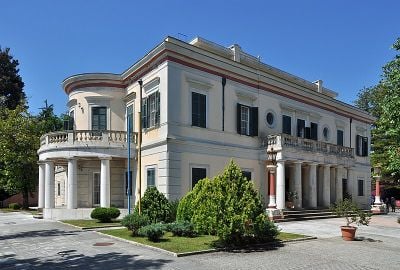
Prince Philip (Greek: Φίλιππος of Greece and Denmark was born on the dining room table in Mon Repos, a villa on the Greek island of Corfu on June 10, 1921,[2] the only son and fifth and final child of Prince Andrew of Greece and Denmark and Princess Alice of Battenberg.[3] A member of the House of Glücksburg, the ruling house of Denmark, he was a prince of both Greece and Denmark by virtue of his patrilineal descent from King George I of Greece and King Christian IX of Denmark, and he was from birth in the line of succession to both thrones. Philip's four elder sisters were Margarita, Theodora, Cecilie, and Sophie.
He was baptized in the Greek Orthodox rite at St. George's Church in the Old Fortress in Corfu. His godparents were his grandmother Queen Olga of Greece, his cousin Crown Prince George of Greece, his uncle Lord Louis Mountbatten, and the mayor of Corfu, Alexandros Kokotos.[4]
Shortly after Philip's birth, his maternal grandfather Prince Louis of Battenberg, then known as Louis Mountbatten, Marquess of Milford Haven, died in London. Louis was a naturalized British subject who, after a career in the Royal Navy, had renounced his German titles and adopted the surname Mountbatten – an Anglicized version of Battenberg – during the First World War, owing to anti-German sentiment in the United Kingdom. After visiting London for his grandfather's memorial service, Philip and his mother returned to Greece where Prince Andrew had remained to command a Greek Army division embroiled in the Greco-Turkish War.[3]
The war went badly for Greece, and the Turks made large gains. Philip's uncle and high commander of the Greek expeditionary force, King Constantine I, was blamed for the defeat and was forced to abdicate on September 27, 1922. The new military government arrested Prince Andrew, along with others. The commanding officer of the army, General Georgios Hatzianestis, and five senior politicians, were arrested, tried, and executed in the Trial of the Six. Prince Andrew's life was also believed to be in danger, and Princess Alice was under surveillance. Finally in December, a revolutionary court banished Prince Andrew from Greece, for life.[5] The British naval vessel HMS Calypso evacuated Prince Andrew's family, with Philip carried to safety in a cot made from a fruit box. Philip's family went to France, where they settled in the Paris suburb of Saint-Cloud in a house lent to them by his wealthy aunt, Princess George of Greece and Denmark.[6]
Because Philip left Greece as a baby, he did not speak Greek. In 1992, he said that he "could understand a certain amount of it."[7] Philip stated that he thought of himself as Danish, and his family spoke English, French, and German.[8] Philip was raised as a Greek Orthodox Christian. As a teenager, he was involved with German Protestantism.[9]
Education
Philip was first educated at The Elms, an American school in Paris run by Donald MacJannet, who described Philip as a "know it all smarty person, but always remarkably polite."[10] Fellow pupils at the school included Princess Anne of Bourbon-Parma, who later married King Michael of Romania. In 1930, he was sent to the United Kingdom to attend Cheam School, living with his maternal grandmother, Victoria Mountbatten, Dowager Marchioness of Milford Haven, at Kensington Palace and his uncle, George Mountbatten, 2nd Marquess of Milford Haven, at Lynden Manor in Bray, Berkshire.[6]
In the next three years, his four sisters married German princes and moved to Germany, his mother was diagnosed with schizophrenia and placed in an asylum,[11] and his father took up residence in Monte Carlo.[12] Philip had little contact with his mother for the remainder of his childhood.[3] In 1933, he was sent to Schule Schloss Salem in Germany, which had the "advantage of saving school fees" because it was owned by the family of his brother-in-law, Berthold, Margrave of Baden.[3] With the rise of Nazism in Germany, Salem's Jewish founder, Kurt Hahn, fled persecution and founded Gordonstoun School in Scotland, to which Philip moved after two terms at Salem.[6]
In 1937, his sister Cecilie, her husband Georg Donatus, Hereditary Grand Duke of Hesse, her two young sons, Ludwig and Alexander, her newborn infant, and her mother-in-law, Princess Eleonore of Solms-Hohensolms-Lich, were killed in an air crash at Ostend; Philip, then 16 years old, attended the funeral in Darmstadt.[11] Both Cecilie and her husband were members of the Nazi Party. The following year, his uncle and guardian Lord Milford Haven died of bone marrow cancer.[3] His younger brother, Lord Louis, took parental responsibility for Philip for the remainder of his youth.[13]
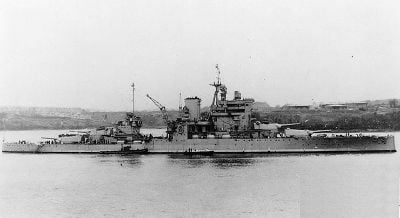
After leaving Gordonstoun in early 1939, Philip completed a term as a cadet at the Royal Naval College, Dartmouth, then repatriated to Greece, living with his mother in Athens for a month in mid-1939. At the behest of the Greek king, George II (his first-cousin), he returned to Britain in September to resume training for the Royal Navy.[12] He graduated from Dartmouth the next year. During the Second World War, he continued to serve in the British forces, while two of his brothers-in-law, Prince Christoph of Hesse and Berthold, Margrave of Baden, fought on the opposing German side.[11]
Philip was appointed as a midshipman in January 1940. He spent four months on the battleship HMS Ramillies, protecting convoys of the Australian Expeditionary Force in the Indian Ocean, followed by shorter postings on HMS Kent, on HMS Shropshire, and in British Ceylon.[12] After the invasion of Greece by Italy in October 1940, he was transferred from the Indian Ocean to the battleship HMS Valiant in the Mediterranean Fleet.[6]

On February 1, 1941 Philip was commissioned as a sub-lieutenant after a series of courses at Portsmouth. Among other engagements, he was involved in the battle of Crete, and was mentioned in dispatches for his service during the battle of Cape Matapan, in which he controlled the battleship's searchlights. He was also awarded the Greek War Cross. In June 1942, he was appointed to the destroyer HMS Wallace, which was involved in convoy escort tasks on the east coast of Britain, as well as the Allied invasion of Sicily.[14]
Promotion to lieutenant followed on July 16, 1942. In October of the same year, he became first lieutenant of HMS Wallace, at 21 years old one of the youngest first lieutenants in the Royal Navy. During the invasion of Sicily, in July 1943, as second in command of Wallace, he saved his ship from a night bomber attack. He devised a plan to launch a raft with smoke floats that successfully distracted the bombers, allowing the ship to slip away unnoticed.[14] In 1944, he moved on to the new destroyer, HMS Whelp, where he saw service with the British Pacific Fleet in the 27th Destroyer Flotilla. He was present in Tokyo Bay when the instrument of Japanese surrender was signed. Philip returned to the United Kingdom on the Whelp in January 1946, and was posted as an instructor at HMS Royal Arthur, the Petty Officers' School in Corsham, Wiltshire.
Marriage
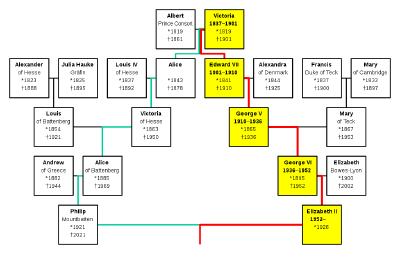
In 1939, King George VI and Queen Elizabeth toured the Royal Naval College, Dartmouth. During the visit, the Queen and Lord Mountbatten asked his nephew Philip to escort the King's two daughters, Elizabeth and Margaret, who were Philip's third cousins through Queen Victoria, and second cousins once removed through King Christian IX of Denmark. Elizabeth fell in love with Philip, and they began to exchange letters when she was 13.[3]
Eventually, in the summer of 1946, Philip asked the King for his daughter's hand in marriage. The King granted his request, provided that any formal engagement be delayed until Elizabeth's 21st birthday the following April.[3] By March 1947, Philip had abandoned his Greek and Danish royal titles, had adopted the surname Mountbatten from his mother's family, and had become a naturalized British subject. The engagement was announced to the public on July 10, 1947.
Though Philip considered himself Anglican, having attended Anglican services with his classmates and relations in England and throughout his Royal Navy days, he had been baptized in the Greek Orthodox Church. The Archbishop of Canterbury, Geoffrey Fisher, wanted to "regularize" Philip's position by officially receiving him into the Church of England,[15] which he did in October 1947.[16]
The day before the wedding, King George VI bestowed the style of Royal Highness on Philip and, on the morning of the wedding, November 20, 1947, he was made the Duke of Edinburgh, Earl of Merioneth, and Baron Greenwich of Greenwich in the County of London. Consequently, being already a Knight of the Garter, between November 19 and 20, 1947 he bore the unusual style Lieutenant His Royal Highness Sir Philip Mountbatten, and is so described in the Letters Patent of November 20, 1947.
Philip and Elizabeth were married in a ceremony at Westminster Abbey, recorded and broadcast by BBC radio to 200 million people around the world.[6] In post-war Britain, it was not acceptable for any of the Duke of Edinburgh's German relations to be invited to the wedding, including Philip's three surviving sisters, all of whom had married German princes. After their marriage, the Duke and Duchess of Edinburgh took up residence at Clarence House. Their first two children were born before Elizabeth succeeded her father as monarch in 1952: Prince Charles in 1948 and Princess Anne in 1950. Their marriage was the longest of any British monarch, lasting more than 73 years until Philip's death in April 2021.

After his honeymoon at the Mountbatten family home, Broadlands, Philip returned to the navy at first in a desk job at the Admiralty, and later on a staff course at the Naval Staff College, Greenwich. From 1949, he was stationed in Malta (residing at Villa Guardamangia) after being posted as the first lieutenant of the destroyer HMS Chequers, the lead ship of the 1st Destroyer Flotilla in the Mediterranean Fleet. On July 16, 1950, he was promoted to lieutenant commander and given command of the frigate HMS Magpie. On June 30, 1952, Philip was promoted to commander, though his active naval career had ended in July 1951.[6]
With the King in ill health, Princess Elizabeth and the Duke of Edinburgh were both appointed to the Privy Council on 4 November 1951, after a coast-to-coast tour of Canada. At the end of January 1952, Philip and his wife set out on a tour of the Commonwealth. On 6 February 1952, they were in Kenya when Elizabeth's father died and she became queen. It was Philip who broke the news to Elizabeth at Sagana Lodge, and the royal party immediately returned to the United Kingdom.[3]
Consort of the Queen
Royal house
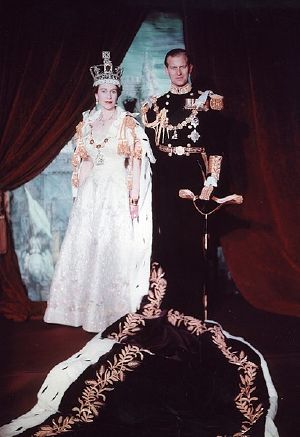
The accession of Elizabeth to the throne brought up the question of the name of the royal house, as Elizabeth would typically have taken Philip's last name upon marriage. The Duke's uncle, Earl Mountbatten of Burma, advocated the name House of Mountbatten. Philip suggested House of Edinburgh, after his ducal title. The government, led by Winston Churchill, who himself later advised the Queen to issue a royal proclamation declaring that the royal house was to remain known as the House of Windsor, rejected both proposals.[17] Prince Philip privately complained, "I am the only man in the country not allowed to give his name to his own children."[3]
On February 8, 1960, several years after the death of Queen Mary and the resignation of Churchill as prime minister, the Queen issued an Order in Council declaring that Mountbatten-Windsor would be the surname of her and her husband's male-line descendants who are not styled as Royal Highness or titled as prince or princess.
After her accession to the throne, the Queen also announced that the Duke was to have "place, pre-eminence and precedence" next to her "on all occasions and in all meetings, except where otherwise provided by Act of Parliament." This meant the Duke took precedence over his son, the Prince of Wales, except, officially, in the British parliament. In fact, however, he attended Parliament only when escorting the Queen for the annual State Opening of Parliament, where he walked and sat beside her. Contrary to rumors over the years, the Queen and Duke were said by insiders to have had a strong relationship throughout their marriage, despite the challenges of Elizabeth's reign. The Queen referred to Prince Philip in a speech on the occasion of her Diamond Jubilee in 2012 as her "constant strength and guide."[18]
Duties and milestones
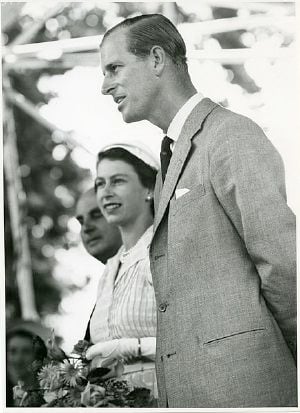
As consort to the Queen, Philip supported his wife in her new duties as sovereign, accompanying her to ceremonies such as the State Opening of Parliament in various countries, state dinners, and tours abroad. As chairman of the Coronation Commission, he was the first member of the royal family to fly in a helicopter, visiting the troops that were to take part in the ceremony. Philip was not crowned in the service, but knelt before Elizabeth, with her hands enclosing his, and swore to be her "liege man of life and limb."[3]
On December 5, 1952 Philip was initiated into Freemasonry by the Worshipful Master of Navy Lodge No 2612, honoring a commitment he had made to the late King, who had made it clear that he expected Philip to maintain the tradition of royal patronage of Freemasonry. However, after his initiation, Philip took no further part in the organization. Although as consort of the Queen, Philip might in time have been made Grand Master of British Freemasonry, the Queen's cousin, Edward, Duke of Kent, assumed that role in 1967.
For six months, over 1953–1954, Philip and Elizabeth toured the Commonwealth; as with previous tours the children were left in Britain.[3]
In 1956, the Duke, with Kurt Hahn, founded The Duke of Edinburgh's Award in order to give young people "a sense of responsibility to themselves and their communities." In the same year, he also established the Commonwealth Study Conferences. From 1956 to 1957, Philip traveled around the world aboard the newly commissioned HMY Britannia, during which he opened the 1956 Summer Olympics in Melbourne and visited the Antarctic, becoming the first royal to cross the Antarctic Circle.[19] The Queen and the children remained in the UK.

On February 22, 1957, Queen Elizabeth granted her husband the style and title of a Prince of the United Kingdom by Letters Patent, and it was gazetted that he was to be known as "His Royal Highness The Prince Philip, Duke of Edinburgh." Philip was appointed to the Queen's Privy Council for Canada on October 14, 1957, taking his Oath of Allegiance before the Queen in person at her Canadian residence, Rideau Hall.[20]
In 1960, Philip attended the National Eisteddfod wearing a long green robe, where he was initiated as an Honorary Ovate by the Archdruid of Wales Edgar Phillips through his bardic name Philip Meirionnydd, to reflect his title of Earl of Merioneth.[21] In 1961, he became the first member of the royal family to be interviewed on television, after he appeared on Panorama to answer questions by Richard Dimbleby about the Commonwealth Technical Training Week, an initiative of which he was patron.[22]
While in Canada in 1969, Philip spoke about his views on republicanism:
It is a complete misconception to imagine that the monarchy exists in the interests of the monarch. It doesn't. It exists in the interests of the people. If at any time any nation decides that the system is unacceptable, then it is up to them to change it.[3]
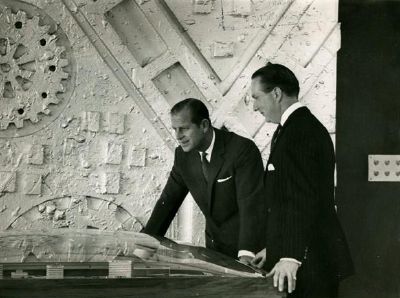
Philip was patron of some 800 organizations, particularly focused on the environment, industry, sport, and education. His first solo engagement as Duke of Edinburgh was in March 1948, presenting prizes at the boxing finals of the London Federation of Boys' Clubs at the Royal Albert Hall. He was president of the National Playing Fields Association (now known as Fields in Trust) for 64 years, from 1947 until his grandson Prince William took over the role in 2013.[23] From 1955 to 1957, he was president of The Football Association and he also served two terms as president of Marylebone Cricket Club in 1949 and 1974.
His environmental conservation work includes helping to found the Australian Conservation Foundation in 1963 and the World Wildlife Fund in 1961; he served as the latter's UK president from 1961 to 1982, international president from 1981, and president emeritus from 1996.[24] He was also president of the Zoological Society of London for two decades and was appointed an honorary fellow in 1977. Despite his involvement in initiatives for conserving nature, he was also criticized for practices such as fox hunting and shooting of game birds.[24]
He was president of the International Equestrian Federation from 1964 to 1986, and served as chancellor of the universities of Cambridge, Edinburgh, Salford, and Wales. In 1965, at the suggestion of Prime Minister Harold Wilson, Philip became chair to a scheme set up for awarding industrial innovations, which later became known as the Queen's Awards for Enterprise. In the same year, Philip became president of the Council of Engineering Institutions and in that capacity he assisted with the inception of the Fellowship of Engineering (later the Royal Academy of Engineering), of which he later became the senior fellow. He also commissioned the Prince Philip Designers Prize and the Prince Philip Medal to recognize designers and engineers with exceptional contributions.[25] In 2017, the British Heart Foundation thanked Prince Philip for being its patron for 55 years, during which time, in addition to organizing fundraisers, he "supported the creation of nine BHF-funded centres of excellence."[26]
Later years

In April 2009, Philip became the longest-serving British royal consort.[27] He became the oldest-ever male British royal in February 2013, and the third-longest-lived member of the British royal family (following Princess Alice, Duchess of Gloucester, and Queen Elizabeth The Queen Mother) in April 2019.[28] Personally, he was not enthused about living an extremely long life, remarking in a 2000 interview (when he was 79) that he could not "imagine anything worse" and had "no desire whatsoever" to become a centenarian, saying "bits of me are falling off already."[29]
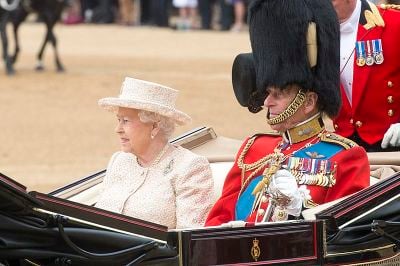
In June 2011, in an interview marking his 90th birthday, he said that he would now slow down and reduce his duties, stating that he had "done [his] bit."[30] His wife, the Queen, gave him the title Lord High Admiral for his 90th birthday.[31]
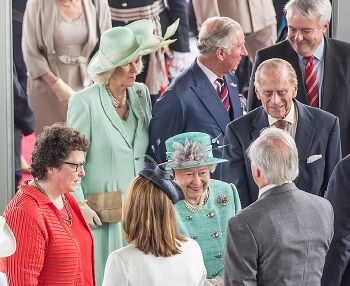
While staying at Sandringham House, the royal residence in Norfolk, on December 23, 2011, the Duke suffered chest pains and was taken to the cardio-thoracic unit at Papworth Hospital, Cambridgeshire, where he underwent successful coronary angioplasty and stenting.[32]
On June 4, 2012, during the celebrations in honor of his wife's Diamond Jubilee, Philip was taken from Windsor Castle to King Edward VII's Hospital suffering from a bladder infection.[33] He was released from hospital on June 9, in time to celebrate his birthday. After a recurrence of infection in August 2012, while staying at Balmoral Castle, he was admitted to Aberdeen Royal Infirmary for five nights as a precautionary measure.[34] In June 2013, Philip was admitted to the London Clinic for an exploratory operation on his abdomen, spending 11 days in hospital.[35] In June 2017, he was taken from Windsor to London and admitted to King Edward VII's Hospital after being diagnosed with an infection. He spent two nights in the hospital and was unable to attend the State Opening of Parliament and Royal Ascot.[36]
Retirement
Prince Philip retired from his royal duties on August 2, 2017, meeting Royal Marines in his final solo public engagement, aged 96. Since 1952 he had completed 22,219 solo engagements. Prime Minister Theresa May thanked him for "a remarkable lifetime of service."[37] On November 20, 2017, he celebrated his 70th wedding anniversary with the Queen, which made her the first British monarch to celebrate a platinum wedding anniversary.[38]
On April 3, 2018, Philip was admitted to King Edward VII's Hospital for a planned hip replacement, which took place the next day. This came after the Duke missed the annual Maundy and Easter Sunday services. On 12 April, his daughter, Princess Anne, spent about 50 minutes in the hospital and afterwards said her father was "on good form." He was discharged the following day.[39] On May 19, six weeks later, he attended the wedding of his grandson Prince Harry to Meghan Markle and was able to walk with the Queen unaided. That October, he accompanied the Queen to the wedding of their granddaughter Princess Eugenie to Jack Brooksbank.[40]
On January 17, 2019, 97-year-old Philip was involved in a car crash as he pulled out onto a main road near the Sandringham Estate. An official statement said he was uninjured. The driver and a passenger of the other car were injured and taken to hospital. Philip apologized,[41] and three weeks later voluntarily surrendered his driving license.[42] The Duke was still allowed to drive around private estates, and was seen behind the wheel in the grounds of Windsor Castle in April 2019.[43]
From December 20 to 24, 2019, Philip stayed at King Edward VII's Hospital and received treatment for a "pre-existing condition," in a visit described by Buckingham Palace as a "precautionary measure."[44] He had not been seen in public since attending Lady Gabriella Kingston's wedding in May 2019. A photo of Philip with the Queen as they isolated at Windsor Castle during the COVID-19 pandemic was released ahead of his 99th birthday in June 2020.[45] In July 2020, he stepped down as Colonel-in-Chief of The Rifles, a position he had held since 2007. He was succeeded by the Duchess of Cornwall.[46]
On January 9, 2021, Philip and the Queen were vaccinated against COVID-19 by a household doctor at Windsor Castle.[47] On February 16, 2021, Philip was admitted to King Edward VII's Hospital as a "precautionary measure" after feeling unwell. He was visited in hospital by Prince Charles. Philip was transferred by ambulance to St Bartholomew's Hospital to continue treatment for an infection, and additionally to undergo "testing and observation" relating to a pre-existing heart condition. He underwent a successful procedure for his heart condition on March 3 and was transferred back to King Edward VII's Hospital before being discharged on March 16.[48]
Death
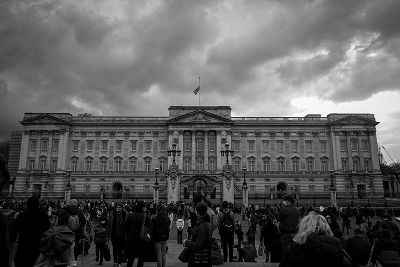
Philip died of "old age" on the morning of April 92021 at Windsor Castle, aged 99, two months before his 100th birthday.[49] In private, the Queen described her husband's death as "having left a huge void in her life."[50]
The palace reported that Philip died peacefully, which was confirmed by Philip's daughter-in-law, the Countess of Wessex, who told the press, it was "...so gentle. It was just like somebody took him by the hand and off he went."[50] His death led to the commencement of Operation Forth Bridge, the plan for publicly announcing his death and organizing his funeral. The funeral took place on April 17, 2021 at St George's Chapel, Windsor Castle, and he was interred in the Royal Vault inside St George's.[51]
Representatives of countries around the world sent condolences to the royal family upon his death.[52]
Legacy
Prince Philip was the longest-serving royal consort in British history.[53] He was a patron, president, or member of over 780 organizations, and he served as chairman of The Duke of Edinburgh's Award, a self-improvement program for young people aged 14 to 24. When he retired from his royal duties on August 2, 2017, aged 96, he had completed 22,219 solo engagements and 5,493 speeches since 1952.[54]
Personality and image

Philip played polo until 1971, when he started to compete in carriage driving, a sport which he helped to expand; the early rule book was drafted under his supervision.[6] He was also a keen yachtsman and struck up a friendship in 1949 with Uffa Fox, in Cowes. Philip and the Queen regularly attended Cowes Week in HMY Britannia.
Philip's first airborne flying lesson took place in 1952 and by his 70th birthday he had accrued 5,150 pilot hours.[6] He was presented with Royal Air Force wings in 1953, helicopter wings with the Royal Navy in 1956, and his private pilot's license in 1959. After 44 years as a pilot, he retired in August 1997 with 5,986 hours spent in 59 different aircraft.[55] In April 2014, it was reported that an old British Pathé newsreel film had been discovered of Philip's 1962 two-month flying tour of South America. Filmed sitting alongside Philip at the aircraft's controls was his co-pilot Captain Peter Middleton, the grandfather of the Duke's granddaughter-in-law, Catherine, Duchess of Cambridge.[56] In 1959, he flew solo in a Druine Turbulent, becoming the first member of the royal family to have flown a single-seat aircraft.[57]
He painted with oils, and collected artworks, including contemporary cartoons, which hang at Buckingham Palace, Windsor Castle, Sandringham House, and Balmoral Castle. Hugh Casson described Philip's own artwork as "exactly what you'd expect ... totally direct, no hanging about. Strong colours, vigorous brushstrokes."[6] He was patron of the Royal Society of Arts from 1952 until 2011. He was "fascinated" by cartoons about the monarchy and the royal family and was a patron of The Cartoon Museum.[58]
As well as a reputation for bluntness and plain speaking,[59] Philip was noted for occasionally making observations and jokes that have been construed as either funny, or as gaffes: awkward, politically incorrect, or even offensive, but sometimes perceived as stereotypical of someone of his age and background.[60][61] In an address to the General Dental Council in 1960, he jokingly coined a new word for his blunders: "Dontopedalogy is the science of opening your mouth and putting your foot in it, a science which I have practised for a good many years."[62] Later in life, he suggested his comments may have contributed to the perception that he was "a cantankerous old sod."[3]
During a state visit to China in 1986, in a private conversation with British students from Xi'an's Northwest University, Philip joked, "If you stay here much longer, you'll go slit-eyed."[63] The British press reported on the remark as indicative of racial intolerance, but the Chinese authorities were reportedly unconcerned. Chinese students studying in the UK, an official explained, were often told in jest not to stay away too long, lest they go "round-eyed."[63] His comment had no effect on Sino-British relations, but it shaped his own reputation.[6]
When he and the Queen met Stephen Menary, an army cadet blinded by a Real IRA bomb, and the Queen inquired how much sight he retained, Philip quipped, "Not a lot, judging by the tie he's wearing." Menary later said: "I think he just tries to put people at ease by trying to make a joke. I certainly didn't take any offence."[64]
Centenary
To mark what would have been Prince Philip's centenary, the Royal Collection Trust held an exhibition at Windsor Castle and the Palace of Holyroodhouse. Titled Prince Philip: A Celebration, it showcased around 150 personal items related to him, including his wedding card, wedding menu, midshipman's logbook from 1940–1941, chair of estate, and the coronation robes and coronet that he wore for his wife's coronation in 1953.[65] George Alexis Weymouth's portrait of the Duke in the ruins of the Castle after the fire of 1992 forms part of a focus on Philip's involvement with the subsequent restoration.[66]
The Royal Horticultural Society marked his centenary by breeding a new rose in his honor. Created by British rose breeder Harkness Roses, it was christened 'The Duke of Edinburgh Rose'. The Queen, Patron of the Royal Horticultural Society, was given the deep pink commemorative rose in honor of her husband, and she remarked that "It looks lovely." A Duke of Edinburgh Rose has since been planted in the mixed rose border of Windsor Castle's East Terrace Garden, where Philip played a major role in the Garden's design.[67]
Titles, styles, and honors

Philip held a number of titles throughout his life. Originally holding the title and style of a prince of Greece and Denmark, Philip abandoned these royal titles prior to his marriage, and was thereafter created a British duke, among other noble titles. The Queen formally issued letters patent in 1957 making Philip a British prince.
When addressing the Duke of Edinburgh, as with any male member of the royal family except the monarch, the rules of etiquette were to address him the first time as Your Royal Highness, and thereafter as Sir.
Honors and honorary military appointments
The Duke of Edinburgh was appointed by King George VI to the Order of the Garter on November 19, 1947, the eve of his wedding. Philip also received 17 different appointments and decorations in the Commonwealth, and 48 from foreign states.

Upon his wife's accession to the throne in 1952, the Duke was appointed Admiral of the Sea Cadet Corps, Colonel-in-Chief of the British Army Cadet Force, and Air Commodore-in-Chief of the Air Training Corps. The following year, he was appointed to the equivalent positions in Canada and made Admiral of the Fleet, Captain General Royal Marines, Field Marshal, and Marshal of the Royal Air Force in the United Kingdom.[6] Subsequent military appointments were made in New Zealand and Australia. In 1975, he was appointed Colonel of the Grenadier Guards, a position he handed over to his son Andrew in 2017. On December 16, 2015, his role as Honorary Air Commodore-in-Chief was handed over to the Duchess of Cambridge.
To celebrate his 90th birthday, the Queen appointed him Lord High Admiral,[68] as well as to the highest ranks available in all three branches of the Canadian Armed Forces.
On their 70th wedding anniversary, November 20, 2017, the Queen appointed him Knight Grand Cross (GCVO) of the Royal Victorian Order, making him the first British national since his uncle Earl Mountbatten of Burma to be entitled to wear the breast stars of four orders of chivalry in the United Kingdom.[69]
Portrayals
Philip has been portrayed by several actors, including Stewart Granger (The Royal Romance of Charles and Diana, 1982), Christopher Lee (Charles & Diana: A Royal Love Story, 1982), David Threlfall (The Queen's Sister, 2005), James Cromwell (The Queen, 2006), and Finn Elliot, Matt Smith, Tobias Menzies, and Jonathan Pryce (The Crown, 2016 onward).
Published works
- Selected Speeches – 1948–55 (1957, revised paperback edition published by Nabu Press in 2011) ISBN 978-1245671330
- Selected Speeches – 1956–59 (1960)
- Birds from Britannia (1962) (published in the United States as Seabirds from Southern Waters) ISBN 978-1163699294
- Wildlife Crisis with James Fisher (1970) ISBN 978-0402125112
- The Environmental Revolution: Speeches on Conservation, 1962–1977 (1978) ISBN 978-0846414537
- Competition Carriage Driving (1982) (published in France 1984, second edition 1984, revised edition 1994) ISBN 978-0851315942
- A Question of Balance (1982) ISBN 978-0859550871
- Men, Machines and Sacred Cows (1984) ISBN 978-0241111741
- A Windsor Correspondence with Michael Mann (1984) ISBN 978-0859551083
- Down to Earth: Collected Writings and Speeches on Man and the Natural World 1961–87 (1988) ISBN 978-0828907118
- Survival or Extinction: A Christian Attitude to the Environment with Michael Mann (1989) ISBN 978-0859551588
- Driving and Judging Dressage (1996) ISBN 978-0851316666
- 30 Years On, and Off, the Box Seat (2004) ISBN 978-0851318981
Ancestry
Both Philip and Queen Elizabeth II are great-great-grandchildren of Queen Victoria, Elizabeth by descent from Victoria's eldest son, King Edward VII, and Philip by descent from Victoria's second daughter, Princess Alice of the United Kingdom. Both are also descended from King Christian IX of Denmark.[6]
Philip was also related to the House of Romanov through both of his parents. He was a direct descendant of Emperor Nicholas I of Russia via his paternal grandmother Grand Duchess Olga Constantinovna of Russia.[70] His maternal grandmother, Princess Victoria of Hesse and by Rhine, was a sister of Alexandra Feodorovna (Alix of Hesse), wife of Emperor Nicholas II.
In 1993, scientists were able to confirm the identity of the remains of several members of the Romanov family, more than seventy years after their deaths in 1918, by comparing their mitochondrial DNA to living matrilineal relatives, including Philip. Philip, Alexandra, and her children are all descended from Princess Alice, the daughter of Queen Victoria, through a purely female line.[71]
Issue
| Name | Birth | Marriage | Their children | Their grandchildren | |
|---|---|---|---|---|---|
| Date | Spouse | ||||
| Charles, Prince of Wales | 14 November 1948 | 29 July 1981 Divorced 28 August 1996 |
Lady Diana Spencer | Prince William, Duke of Cambridge | Template:Ubli |
| Prince Harry, Duke of Sussex | Archie Mountbatten-Windsor | ||||
| 9 April 2005 | Camilla Parker Bowles | None | |||
| Anne, Princess Royal | 15 August 1950 | 14 November 1973 Divorced 23 April 1992 |
Mark Phillips | Peter Phillips | Template:Ubli |
| Zara Tindall | Template:Ubli | ||||
| 12 December 1992 | Timothy Laurence | None | |||
| Prince Andrew, Duke of York | 19 February 1960 | 23 July 1986 Divorced 30 May 1996 |
Sarah Ferguson | Princess Beatrice, Mrs Edoardo Mapelli Mozzi | None |
| Princess Eugenie, Mrs Jack Brooksbank | August Brooksbank | ||||
| Prince Edward, Earl of Wessex | 10 March 1964 | 19 June 1999 | Sophie Rhys-Jones | Lady Louise Windsor | None |
| James, Viscount Severn | None | ||||
Notes
- ↑ 1.0 1.1 He was born on June 10, 1921 according to the Gregorian calendar. Until March 1923, Greece used the Julian calendar, in which the date is May 28, 1921.
- ↑ Alan Hamilton, Royal Handbook (Littlehampton Book Services Ltd, 1985, ISBN 0855335661).
- ↑ 3.00 3.01 3.02 3.03 3.04 3.05 3.06 3.07 3.08 3.09 3.10 3.11 3.12 Gyles Brandreth, Philip and Elizabeth: Portrait of a Royal Marriage (W.W. Norton & Company, 2006, ISBN 0393329496).
- ↑ Alex Sakalis, Prince Philip's secret return visit to the island of his birth The Independent, April 17, 2021. Retrieved July 14, 2021.
- ↑ Sarah Wilson, Was Prince Philip Greek? Why the Duke of Edinburgh was exiled from Greece – and Denmark links explained National World, April 17, 2021. Retrieved July 14, 2021.
- ↑ 6.00 6.01 6.02 6.03 6.04 6.05 6.06 6.07 6.08 6.09 6.10 6.11 Tim Heald, The Duke: A portrait of Prince Philip (Hodder & Stoughton, 1991, ISBN 0340546077)
- ↑ Jonathan Spangler, Prince Philip dies: his marriage to the Queen and their part in 1,000 years of European royal dynastic history The Conversation. Retrieved July 14, 2021.
- ↑ Fiammetta Rocco, A strange life: Profile of Prince Philip The Independent, February 16, 2014. Retrieved July 14, 2021.
- ↑ Nicholas Davies, Elizabeth: Behind Palace Doors (Mainstream Pub. Co. Ltd, 2000, ISBN 1840184019).
- ↑ Sydney Zatz, Remembering Philip: The Prince’s School Days Royal Central, April 16, 2021. Retrieved July 13, 2021.
- ↑ 11.0 11.1 11.2 Hugo Vickers, Alice: Princess Andrew of Greece (St. Martin's Press, 2002, ISBN 0312288867).
- ↑ 12.0 12.1 12.2 Philip Eade, Prince Philip: The Turbulent Early Life of the Man Who Married Queen Elizabeth II (Henry Holt and Co., 2011, ISBN 0805095446).
- ↑ Prince Philip: A turbulent childhood stalked by exile, mental illness and death BBC News, April 10, 2021. Retrieved July 15, 2021.
- ↑ 14.0 14.1 David Smith, Prince Philip's war heroics come to light after 60 years The Guardian, December 28, 2003. Retrieved July 15, 2021.
- ↑ Basil Boothroyd, Prince Philip: An informal biography (McCall Pub. Co, 1971, ISBN 0841501165).
- ↑ Elizabeth's Fiance Now an Anglican The New York Times, October 4, 1947. Retrieved July 15, 2021.
- ↑ Emma Soames, Emma Soames in The Telegraph: As Churchills We’re Proud to do Our Duty International Churchill Society, June 1, 2012. Retrieved July 15, 2021.
- ↑ Prince Philip: The man at the Queen's side ITV News, June 5, 2012. Retrieved July 15, 2021.
- ↑ Roya Nikkhah, Prince Philip: The Duke you don't know The Telegraph, January 25, 2011. Retrieved July 15, 2021.
- ↑ Arthur Bousfield and Garry Toffoli, Fifty Years the Queen: A Tribute to Elizabeth II on Her Golden Jubilee (Dundurn, 2002, ISBN 1550023608).
- ↑ Prince Philip: The Duke of Edinburgh and Wales in light and dark times BBC News, April 9, 2021. Retrieved July 15, 2021.
- ↑ First TV interview by a member of the Royal Family BBC, May 29, 1961. Retrieved July 15, 2021.
- ↑ The History of Fields in Trust Fields in Trust. Retrieved July 15, 2021.
- ↑ 24.0 24.1 Joe Sommerlad, How Prince Philip tackled conservation and climate change The Independent, April 9, 2021. Retrieved July 15, 2021.
- ↑ The Prince Philip Designers Prize Design Council. Retrieved July 15, 2021.
- ↑ Our Chief Executive thanks Prince Philip for his commitment as Patron British Heart Foundation, May 4, 2017. Retrieved July 15, 2021.
- ↑ Prince Philip reaches milestone BBC News, April 18, 2009. Retrieved July 15, 2021.
- ↑ Prince Philip, 97, becomes third oldest royal (and oldest ever male) in British history – but who is number one? ITV News, April 19, 2019. Retrieved July 15, 2021.
- ↑ Victoria Ward, Duke of Edinburgh proves reluctant celebrant ahead of his 100th birthday The Telegraph, December 27, 2020. Retrieved July 15, 2021.
- ↑ Prince Philip Turns 90 and Vows to 'Slow Down' BBC News,|June 10, 2011. Retrieved July 15, 2021.
- ↑ New title for Duke of Edinburgh as he turns 90 BBC News, June 10, 2011. Retrieved July 15, 2021.
- ↑ Prince Philip has heart procedure at Papworth Hospital BBC News, December 24, 2011. Retrieved July 15, 2021.
- ↑ Prince Philip in hospital and to miss Diamond Jubilee concert BBC News, June 4, 2012. Retrieved July 15, 2021.
- ↑ Prince Philip leaves Aberdeen hospital after five nights BBC News, August 20, 2012. Retrieved July 15, 2021.
- ↑ Richard Allen Greene, Prince Philip leaves hospital, will recuperate at Windsor Castle CNN, June 17, 2013. Retrieved July 15, 2021.
- ↑ Caroline Davies, Prince Philip to spend second night in hospital The Guardian, June 21, 2017. Retrieved July 15, 2021.
- ↑ Prince Philip carries out final official engagement BBC News, August 2, 2017. Retrieved July 15, 2021.
- ↑ Queen and Prince Philip portraits released to mark 70th anniversary The Guardian, November 20, 2017. Retrieved July 15, 2021.
- ↑ Duke of Edinburgh leaves hospital BBC News, April 13, 2018. Retrieved July 15, 2021.
- ↑ Princess Eugenie wedding in pictures: Splendid hats and gusts of wind BBC News, October 12, 2018. Retrieved July 15, 2021.
- ↑ Victoria Ward, Prince Philip sends personal apology to victims of Sandringham car crash The Telegraph, January 27, 2019. Retrieved July 15, 2021.
- ↑ Lin Jenkins, Prince Philip gives up driving licence three weeks after car crash The Guardian, February 9, 2019. Retrieved July 15, 2021.
- ↑ Prince Philip 'spotted behind wheel for first time since giving up licence' Irish Examiner, April 18, 2019. Retrieved July 15, 2021.
- ↑ Prince Philip leaves hospital to spend Christmas with the Queen The Independent, December 24, 2019. Retrieved July 15, 2021.
- ↑ Prince Philip: Photo with Queen to mark Duke of Edinburgh's 99th birthday BBC News, June 9, 2020. Retrieved July 15, 2021.
- ↑ Prince Philip steps down as Colonel-in-Chief of The Rifles BBC News, July 22, 2020. Retrieved July 15, 2021.
- ↑ Queen and Prince Philip receive vaccinations BBC News, January 9, 2021. Retrieved July 15, 2021.
- ↑ Prince Philip: Duke of Edinburgh leaves hospital after a month BBC News, April 12, 2021. Retrieved July 15, 2021.
- ↑ Victoria Ward, Exclusive: Duke of Edinburgh's official cause of death recorded as 'old age' The Telegraph, May 4, 2021. Retrieved July 15, 2021.
- ↑ 50.0 50.1 Caroline Davies, Queen says Prince Philip's death has left 'a huge void' The Guardian, April 11, 2021. Retrieved July 15, 2021.
- ↑ Prince Philip funeral: Pictures as Queen and nation bid farewell to the duke BBC News, April 17, 2021. Retrieved July 15, 2021.
- ↑ Prince Philip: World leaders and royals send heartfelt sympathy BBC News, April 11, 2021. Retrieved July 15, 2021.
- ↑ Prince Philip has died aged 99, Buckingham Palace announces BBC News, April 12, 2021. Retrieved July 15, 2021.
- ↑ Valentine Low, Prince Philip was a man determined to make an impact The Times, April 9, 2021. Retrieved July 15, 2021.
- ↑ Twenty Things You Didn't Know About Philip Sky News, June 9, 2011. Retrieved July 15, 2021.
- ↑ Matthew Sparkes, Royal couples' grandparents' jet-age meeting The Telegraph, April 22, 2014. Retrieved July 15, 2021.
- ↑ Prince Philip: Derby plane flown by duke to be restored BBC News, April 14, 2021. Retrieved July 15, 2021.
- ↑ Royals 'natural targets' for cartoons, but Philip 'saw humour in everything', says The Cartoon Museum ITV News, April 14, 2021. Retrieved July 16, 2021.
- ↑ Prince Philip at 90 on a lifetime of speaking his mind BBC News, June 9, 2011. Retrieved July 16, 2021.
- ↑ Stephanie Kennedy, Prince Philip reminded of blunders on his 85th birthday Australian Broadcasting Corporation, June 10, 2006. Retrieved July 15, 2021.
- ↑ Paul Duggan, Prince Philip Has a Mouthful Of a Title. And, Often, His Foot The Washington Post, May 5, 2007. Retrieved July 16, 2021.
- ↑ Karen Dolby, The Wicked Wit of Queen Elizabeth II (Michael O'Mara, 2015, ISBN 1782433651).
- ↑ 63.0 63.1 Robert Lacey, Royal : Her Majesty Queen Elizabeth II (Time Warner Books UK, 2002, ISBN 0316859400).
- ↑ Ben Leach, Duke of Edinburgh gaffes by mocking blind boy The Telegraph, December 14, 2009. Retrieved July 16, 2021.
- ↑ Jack Malvern, Palace exhibitions to celebrate Prince Philip’s life The Times, June 8, 2021. Retrieved July 16, 2021.
- ↑ Rebecca Cope, ‘Prince Philip: A Celebration’ makes its debut at Windsor Castle Tatler, June 24, 2021.
- ↑ Annie Goldsmith, Queen Elizabeth Is Given a New Rose Named in Honor of Prince Philip Town & Country, Jun 9, 2021. Retrieved July 16, 2021.
- ↑ The Duke of Edinburgh appointed Lord High Admiral Royal.uk, June 10, 2011. Retrieved July 16, 2021.
- ↑ Hannah Furness, Queen grants new honour to Prince Philip for 70th wedding anniversary The Telegraph, November 20, 2017. Retrieved July 16, 2021.
- ↑ Hugh Montgomery-Massingberd, Royal Families of the World {Burke's Peerage, 1997, ISBN 0850110238).
- ↑ Peter Gill, Pavel L. Ivanov, Colin Kimpton, Romelle Piercy, Nicola Benson, Gillian Tully, Ian Evett, Erika Hagelberg, and Kevin Sullivan, Identification of the remains of the Romanov family by DNA analysis Nature Genetics 6(2) (February 1994):130–135. Retrieved July 15, 2021.
References
ISBN links support NWE through referral fees
- Boothroyd, Basil. Prince Philip: An informal biography. McCall Pub. Co, 1971. ISBN 0841501165
- Bousfield, Arthur, and Garry Toffoli. Fifty Years the Queen: A Tribute to Elizabeth II on Her Golden Jubilee. Dundurn, 2002. ISBN 1550023608
- Brandreth, Gyles. Philip and Elizabeth: Portrait of a Royal Marriage. W.W. Norton & Company, 2006. ISBN 0393329496
- Davies, Nicholas. Elizabeth: Behind Palace Doors. Mainstream Pub. Co. Ltd, 2000. ISBN 1840184019
- Dolby, Karen. The Wicked Wit of Queen Elizabeth II. Michael O'Mara, 2015. ISBN 1782433651
- Eade, Philip. Prince Philip: The Turbulent Early Life of the Man Who Married Queen Elizabeth II. Henry Holt and Co., 2011. ISBN 0805095446
- Hamilton, Alan. Royal Handbook. Littlehampton Book Services Ltd, 1985. ISBN 0855335661)
- Heald, Tim. The Duke: A portrait of Prince Philip. Hodder & Stoughton, 1991. ISBN 0340546077
- Montgomery-Massingberd, Hugh. Royal Families of the World. Burke's Peerage, 1997. ISBN 0850110238
- Vickers, Hugo. Alice: Princess Andrew of Greece. St. Martin's Press, 2002. ISBN 0312288867
External links
All links retrieved November 30, 2022.
- The Duke of Edinburgh 1921-2021 The Royal Family website
- Obituary: HRH The Prince Philip, Duke of Edinburgh BBC News
- The Duke of Edinburgh's Award
| British royalty | ||
|---|---|---|
| Preceded by: Elizabeth Bowes-Lyon |
Consort of the British monarch 6 February 1952 – 9 April 2021 |
Vacant |
| Peerage of the United Kingdom |
||
| New Title | Duke of Edinburgh 1947–2021 |
Succeeded by: The Prince of Wales |
| Academic offices | ||
| Preceded by: The Marquess of Linlithgow |
Chancellor of the University of Edinburgh 1953–2010 |
Succeeded by: The Princess Royal |
| New Title | Chancellor of the University of Salford 1967–1991 |
Succeeded by: The Duchess of York |
| Preceded by: The Lord Adrian |
Chancellor of the University of Cambridge 1976–2011 |
Succeeded by: The Lord Sainsbury of Turville |
| Honorary Titles | ||
| Preceded by: Queen Mary |
Grand Master of the Order of the British Empire 24 March 1953 – 9 April 2021 |
Vacant |
| Preceded by: King George VI |
Air Commodore-in-Chief of the Air Training Corps 1953–2015 |
Succeeded by: The Duchess of Cambridge |
| New Title | Colonel-in-Chief of The Rifles 2007–2020 |
Succeeded by: The Duchess of Cornwall |
| Military offices | ||
| Preceded by: Queen Elizabeth II |
Lord High Admiral 10 June 2011 – 9 April 2021 |
Vacant |
Credits
New World Encyclopedia writers and editors rewrote and completed the Wikipedia article in accordance with New World Encyclopedia standards. This article abides by terms of the Creative Commons CC-by-sa 3.0 License (CC-by-sa), which may be used and disseminated with proper attribution. Credit is due under the terms of this license that can reference both the New World Encyclopedia contributors and the selfless volunteer contributors of the Wikimedia Foundation. To cite this article click here for a list of acceptable citing formats.The history of earlier contributions by wikipedians is accessible to researchers here:
- Prince_Philip,_Duke_of_Edinburgh history
The history of this article since it was imported to New World Encyclopedia:
- History of "Prince Philip, Duke of Edinburgh"
Note: Some restrictions may apply to use of individual images which are separately licensed.
↧ Download as ZWI file | Last modified: 02/04/2023 05:58:42 | 16 views
☰ Source: https://www.newworldencyclopedia.org/entry/Prince_Philip,_Duke_of_Edinburgh | License: CC BY-SA 3.0
 ZWI signed:
ZWI signed: KSF
KSF